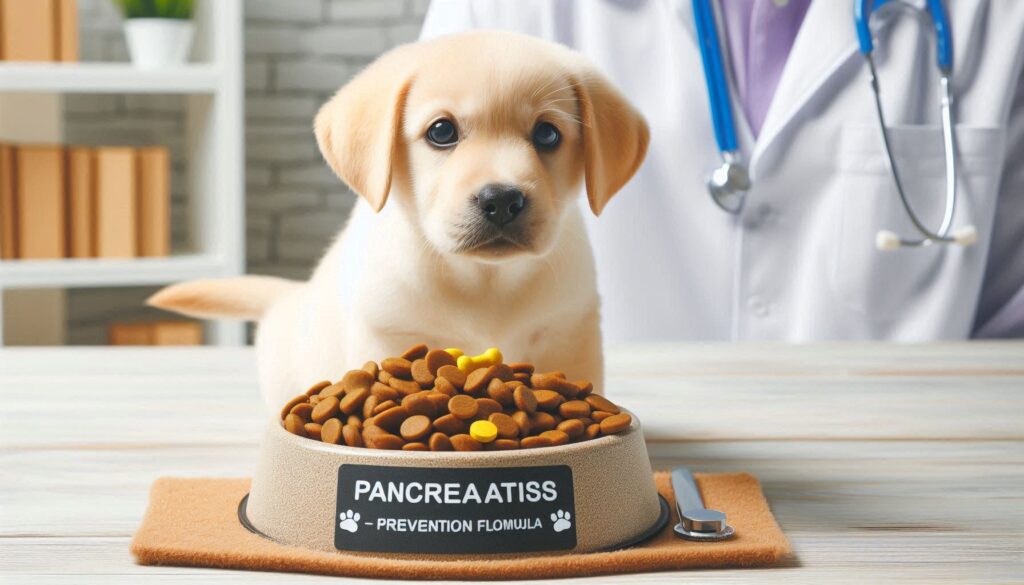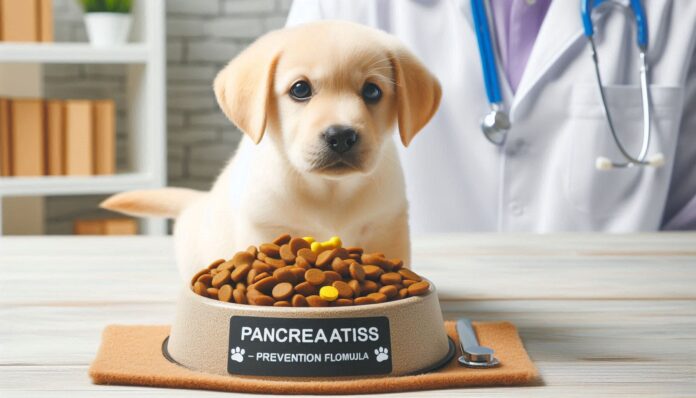As a devoted dog owner, nothing is more important than ensuring the health and happiness of your furry friend. When it comes to preventing pancreatitis in dogs, selecting the right food can make all the difference. In this comprehensive guide, we’ll explore everything you need to know about choosing the best dog food for pancreatitis prevention, helping you make informed decisions to keep your canine companion healthy and thriving.

Understanding Canine Pancreatitis
Before we delve into the specifics of dog food for pancreatitis prevention, it’s crucial to understand what pancreatitis is and how it affects our four-legged friends.
Pancreatitis is an inflammation of the pancreas, a vital organ responsible for producing digestive enzymes and hormones that regulate blood sugar. When the pancreas becomes inflamed, it can lead to a range of symptoms, including:
- Vomiting
- Abdominal pain
- Loss of appetite
- Lethargy
- Diarrhea
- Fever
If left untreated, pancreatitis can become a severe and potentially life-threatening condition for dogs. That’s why prevention through proper nutrition is so important.
The Role of Diet in Pancreatitis Prevention
Diet plays a crucial role in preventing pancreatitis in dogs. The right food can help reduce the risk of inflammation and support overall pancreatic health. Here are some key factors to consider when choosing dog food for pancreatitis prevention:
1. Low-Fat Content
One of the most important aspects of a pancreatitis-prevention diet is low fat content. Excess fat can put strain on the pancreas, increasing the risk of inflammation. Look for dog foods with a fat content of 10% or less on a dry matter basis.
2. High-Quality Protein Sources
Opt for dog foods that contain high-quality, easily digestible protein sources. Good options include:
- Chicken
- Turkey
- Fish (such as salmon or whitefish)
- Lean beef
Avoid foods with byproducts or unspecified meat sources, as these can be harder for your dog to digest.
3. Complex Carbohydrates
Choose foods that contain complex carbohydrates, which provide a steady source of energy and help regulate blood sugar levels. Good options include:
- Sweet potatoes
- Brown rice
- Oatmeal
- Quinoa
4. Fiber-Rich Ingredients
Fiber is essential for maintaining a healthy digestive system and can help prevent pancreatitis. Look for foods that include fiber-rich ingredients such as:
- Pumpkin
- Green beans
- Carrots
- Peas
5. Limited Ingredients
Dogs prone to pancreatitis may benefit from limited ingredient diets, which can help reduce the risk of food sensitivities and digestive issues.
Top 5 Dog Food Recommendations for Pancreatitis Prevention
Based on extensive research and consultation with veterinary nutritionists, here are our top 5 recommendations for dog food that can help prevent pancreatitis:
- Hill’s Science Diet Adult Sensitive Stomach & Skin
- Low-fat content (12% max)
- High-quality protein from chicken
- Easily digestible ingredients
- Check price on Amazon
- Royal Canin Gastrointestinal Low Fat
- Ultra-low fat content (5.5% min)
- Highly digestible proteins
- Prebiotic fibers for digestive health
- Learn more at Royal Canin
- Purina Pro Plan Focus Sensitive Skin & Stomach
- Salmon as the first ingredient
- Easily digestible carbohydrates
- No artificial colors or flavors
- View on Chewy
- Blue Buffalo Basics Limited Ingredient Diet
- Single animal protein source (turkey)
- Pea fiber for digestive health
- No chicken, beef, corn, wheat, soy, dairy, or eggs
- Check reviews on PetSmart
- Wellness CORE Digestive Health
- Probiotics and prebiotic fibers
- Easily digestible protein sources
- Omega-3 fatty acids for coat health
- Learn more at Wellness Pet Food
Remember to always consult with your veterinarian before making any significant changes to your dog’s diet, especially if they have a history of pancreatitis or other health issues.
Tips for Transitioning to a New Dog Food
When switching to a new dog food for pancreatitis prevention, it’s essential to make the transition gradually to avoid digestive upset. Here’s a recommended timeline:
- Days 1-3: 75% old food, 25% new food
- Days 4-6: 50% old food, 50% new food
- Days 7-9: 25% old food, 75% new food
- Day 10 and beyond: 100% new food
Monitor your dog closely during the transition period for any signs of digestive issues or discomfort.
Additional Strategies for Pancreatitis Prevention
While choosing the right dog food is crucial for preventing pancreatitis, there are other steps you can take to support your dog’s pancreatic health:
- Maintain a healthy weight: Obesity is a risk factor for pancreatitis. Work with your vet to determine your dog’s ideal weight and develop a plan to achieve it if necessary.
- Avoid table scraps: Human foods, especially those high in fat, can trigger pancreatitis in dogs. Stick to dog-specific treats and avoid sharing your meals.
- Regular exercise: Keep your dog active with daily walks and playtime to support overall health and maintain a healthy weight.
- Stay hydrated: Ensure your dog always has access to fresh, clean water to support digestive health.
- Regular check-ups: Schedule regular veterinary check-ups to monitor your dog’s health and catch any potential issues early.
The Importance of Individualized Care
Every dog is unique, and what works for one may not work for another. Some dogs may require a prescription diet or additional supplements to manage their pancreatitis risk. Always work closely with your veterinarian to develop a tailored nutrition plan that meets your dog’s specific needs.
Dr. Sarah Thompson, a board-certified veterinary nutritionist, emphasizes the importance of individualized care: “While general guidelines for pancreatitis prevention are helpful, it’s crucial to consider each dog’s individual health history, age, breed, and lifestyle when developing a nutrition plan. What works for a sedentary senior dog may not be appropriate for an active young adult.”
Real-Life Success Stories
Many dog owners have seen remarkable improvements in their pets’ health after switching to a pancreatitis-prevention diet. For example, John from Seattle shares his experience:
“My 8-year-old Labrador, Max, had two bouts of pancreatitis in one year. After consulting with our vet and switching to a low-fat, easily digestible diet, he hasn’t had any issues for over two years now. It’s amazing what the right food can do!”
You can find more success stories and connect with other dog owners dealing with pancreatitis on forums like DogForum.com or PetGuide.com.
The Role of Supplements in Pancreatitis Prevention
While a balanced diet is the foundation of pancreatitis prevention, some supplements may offer additional support for pancreatic health. Always consult with your veterinarian before adding any supplements to your dog’s diet. Some potentially beneficial supplements include:
- Probiotics: These can help support a healthy gut microbiome, which is crucial for overall digestive health. Look for dog-specific probiotic supplements or foods that contain added probiotics.
- Omega-3 fatty acids: While it’s important to limit overall fat intake, omega-3 fatty acids have anti-inflammatory properties that may benefit dogs at risk of pancreatitis. Fish oil supplements designed for dogs can be a good source.
- Digestive enzymes: Some dogs may benefit from supplemental digestive enzymes to support pancreatic function. However, these should only be used under veterinary guidance.
- Vitamin B complex: B vitamins play a crucial role in metabolism and may support pancreatic health. Your vet may recommend a B-complex supplement if they feel it’s necessary.
Remember, supplements should never replace a balanced diet or veterinary care. They should be used as part of a comprehensive health plan developed in conjunction with your veterinarian.
Understanding Food Labels: What to Look For
Navigating dog food labels can be challenging, but it’s an essential skill for choosing the best food for pancreatitis prevention. Here are some key things to look for:
- Named protein source: Look for specific protein sources like “chicken” or “salmon” rather than generic terms like “meat” or “animal protein.”
- Fat content: Remember to aim for a fat content of 10% or less on a dry matter basis. You may need to contact the manufacturer for this information, as the percentages on the label are often “as fed” rather than dry matter basis.
- Fiber content: A moderate amount of fiber (around 3-5%) can be beneficial for dogs at risk of pancreatitis.
- Limited ingredients: Fewer ingredients can mean less stress on the digestive system. Look for foods with a relatively short ingredient list.
- No artificial preservatives or colors: These additives are unnecessary and may cause digestive upset in some dogs.
- AAFCO statement: Look for foods that meet AAFCO (Association of American Feed Control Officials) standards for complete and balanced nutrition.
The Future of Canine Nutrition and Pancreatitis Prevention
As our understanding of canine nutrition evolves, so do the strategies for preventing and managing pancreatitis in dogs. Researchers are continually studying the links between diet and pancreatic health, and we can expect to see more tailored nutritional solutions in the future.
Dr. Emily Roberts, a veterinary researcher specializing in canine nutrition, shares her insight: “We’re seeing promising results from studies on specific nutrients and their role in pancreatic health. For example, certain medium-chain triglycerides may have protective effects on the pancreas. In the coming years, we may see more dog foods formulated with these targeted nutrients to support pancreatic function.”
Stay informed about the latest developments in canine nutrition by following reputable sources like the American College of Veterinary Nutrition or the World Small Animal Veterinary Association’s Global Nutrition Committee.
Conclusion: A Holistic Approach to Canine Health
Choosing the right dog food for pancreatitis prevention is a crucial step in maintaining your furry friend’s health, but it’s just one part of a holistic approach to canine wellness. By combining appropriate nutrition with regular exercise, veterinary check-ups, and plenty of love and attention, you can give your dog the best chance at a long, healthy, and happy life.
Remember, every dog is unique, and what works for one may not work for another. Stay attentive to your dog’s needs, monitor their health closely, and don’t hesitate to reach out to your veterinarian with any concerns. With the right care and nutrition, you can help your beloved companion thrive and reduce their risk of pancreatitis.
FAQ: Dog Food for Pancreatitis Prevention
- Q: Can I feed my dog homemade food to prevent pancreatitis?
A: While homemade diets can be an option for some dogs, it’s crucial to work with a veterinary nutritionist to ensure the diet is balanced and appropriate for pancreatitis prevention. Homemade diets can be challenging to formulate correctly and may lack essential nutrients if not carefully planned. If you’re interested in preparing homemade meals for your dog, consult with your veterinarian or a board-certified veterinary nutritionist to develop a suitable recipe that meets all of your dog’s nutritional needs while supporting pancreatic health. - Q: How often should I feed my dog to help prevent pancreatitis?
A: For dogs at risk of pancreatitis, it’s often recommended to feed smaller, more frequent meals throughout the day rather than one or two large meals. This approach can help reduce the workload on the pancreas and minimize the risk of inflammation. A common feeding schedule might involve 3-4 small meals spread throughout the day. However, the ideal feeding frequency can vary depending on your dog’s individual needs, so it’s best to discuss this with your veterinarian to determine the most appropriate schedule for your pet. - Q: Are grain-free diets good for preventing pancreatitis in dogs?
A: Grain-free diets are not necessarily better for preventing pancreatitis in dogs. In fact, some grain-free diets may be higher in fat content, which could potentially increase the risk of pancreatitis. The key factors in choosing a diet for pancreatitis prevention are low fat content, high-quality protein sources, and easily digestible ingredients. Grains can be a good source of complex carbohydrates and fiber, which can be beneficial for dogs at risk of pancreatitis. Unless your dog has a specific grain allergy or intolerance (which is relatively rare), there’s no need to avoid grains in their diet. Always prioritize the overall nutritional balance and quality of the food rather than focusing solely on whether it’s grain-free or not. - Q: Can treats contribute to pancreatitis in dogs?
A: Yes, treats can potentially contribute to pancreatitis in dogs, especially if they are high in fat or given in large quantities. Many commercial dog treats are high in fat and calories, which can put strain on the pancreas and increase the risk of inflammation. When choosing treats for a dog at risk of pancreatitis, opt for low-fat options or consider using small pieces of their regular kibble as treats. Alternatively, you can use healthy, low-fat human foods as occasional treats, such as small pieces of carrot, green beans, or apple (without seeds). Always remember that treats should make up no more than 10% of your dog’s daily caloric intake. If you’re unsure about which treats are safe for your dog, consult with your veterinarian for recommendations. - Q: How long does it take to see improvements after switching to a pancreatitis-prevention diet?
A: The timeline for seeing improvements after switching to a pancreatitis-prevention diet can vary depending on the individual dog and the severity of their condition. Some dogs may show improvements in digestion and overall well-being within a few weeks of transitioning to the new diet. However, for dogs with chronic or recurring pancreatitis, it may take several months of consistent feeding with the appropriate diet to see significant improvements in their condition. It’s important to be patient and consistent with the new diet, and to closely monitor your dog for any changes in their symptoms or overall health. Keep in regular communication with your veterinarian during this transition period, as they may need to adjust the treatment plan based on your dog’s response to the new diet. Remember that diet is just one aspect of managing pancreatitis risk, and other factors such as medication, weight management, and lifestyle changes may also play a role in your dog’s improvement.


